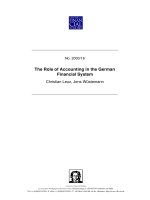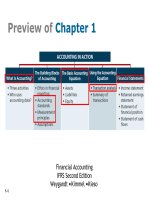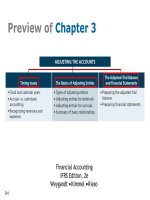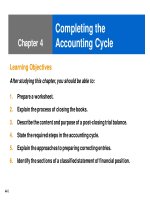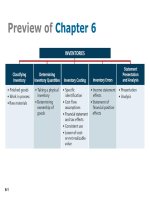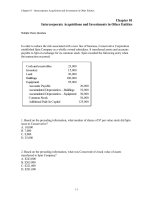Financial accounting chapter 01 accounting in action
Bạn đang xem bản rút gọn của tài liệu. Xem và tải ngay bản đầy đủ của tài liệu tại đây (1.2 MB, 53 trang )
1-1
Preview of Chapter 1
Financial Accounting
IFRS Second Edition
Weygandt Kimmel Kieso
1-2
Chapter 1
Accounting in Action
Learning Objectives
After studying this chapter, you should be able to:
1. Explain what accounting is.
2. Identify the users and uses of accounting.
3. Understand why ethics is a fundamental business concept.
4. Explain accounting standards and the measurement principles.
5. Explain the monetary unit assumption and the economic entity
assumption.
6. State the accounting equation, and define its components.
7. Analyze the effects of business transactions on the accounting equation.
8. Understand the four financial statements and how they are prepared.
1-3
LO 1 Explain what accounting is.
Accounting consists of three basic activities - it
identifies,
records, and
communicates
the economic events of an organization to interested users.
What is Accounting?
1-4
Three Activities
Illustration 1-1
The activities of the
accounting process
The accounting process includes
the bookkeeping function.
What is Accounting?
LO 1 Explain what accounting is.
1-5
( 단위 : 억원 )
재무상태표
2009.06.30 2010.06.30 2010.12.31 2011.03.31
자 산
29,653 36,540 38,452 38,325
부 채
27,585 34,206 36,047 36,197
자 본
2,067 2,334 2,405 2,127
손익계산서
08.7.1-09.6.30 09.7.1-10.6.30 10.7.1-10.12.31 10.7.1-11.3.31
영업수익
3,136 3,068 1,678 2,521
영업비용
(2,661) (2,936) (1,619) (2,635)
영업손익
474 132 58 -114
당기순손익
308 147 66 -196
현금흐름표
08.7.1-09.6.30 09.7.1-10.6.30 10.7.1-10.12.31 10.7.1-11.3.31
영업활동
-3,865 -6,748 -2,332 -2,542
투자활동
-4,816 -6 -23 -87
재무활동
4,019 6,887 1,751 1,901
1-6
1-7
Management
Human
Resources
Taxing
Authorities
Labor
Unions
Regulatory
Agencies
Marketing
Finance
Investors
Creditors
Customers
Internal
Users
External
Users
Who Uses Accounting Data
LO 2 Identify the users and uses of accounting.
Information
Why ?
1-8
International Financial Reporting Standards (IFRS)
LO 4 Explain accounting standards and the measurement principles.
Financial Accounting Standards Board (FASB)
/>International Accounting Standards Board (IASB)
/>Generally Accepted Accounting Principles (GAAP)
The Building Blocks of Accounting
Accounting Standards
2011year
1-9
Cost Principle – or historical cost principle, dictates that
companies record assets at their cost.
Fair Value Principle – states that assets and liabilities
should be reported at fair value (the price received to sell an
asset or settle a liability).
Measurement Principles
The Building Blocks of Accounting
LO 4 Explain accounting standards and the measurement principles.
1-10
Team Quiz #1
1) The hiring of a new company president is an economic event
recorded by the financial information system. F
2) Management of a business enterprise is the major external user
of information. F
3) Bookkeeping and accounting are one and the same because the
bookkeeping function includes the accounting process. F
4) International Financial Reporting Standards are determined by
the IASB. T
5) IFRS follows one measurement principle known as the historical
cost principle. F
1-11
Assets
Assets
Assets
Assets
Liabilities
Liabilities
Liabilities
Liabilities
Equity
Equity
Equity
Equity
=
+
Provides the underlying framework for recording and
summarizing economic events.
Applies to all economic entities regardless of size.
The Basic Accounting Equation
LO 6 State the accounting equation, and define its components.
1-12
Assets
Assets
Assets
Assets
Provides the underlying framework for recording and
summarizing economic events.
Resources a business owns.
Provide future services or benefits.
Cash, Inventory, Equipment, etc.
Assets
Liabilities
Liabilities
Liabilities
Liabilities
Equity
Equity
Equity
Equity
=
+
LO 6 State the accounting equation, and define its components.
The Basic Accounting Equation
1-13
Provides the underlying framework for recording and
summarizing economic events.
Liabilities
Assets
Assets
Assets
Assets
Liabilities
Liabilities
Liabilities
Liabilities
=
+
Equity
Equity
Equity
Equity
LO 6 State the accounting equation, and define its components.
The Basic Accounting Equation
Claims against assets (debts and obligations).
Creditors - party to whom money is owed.
Accounts payable, Notes payable, etc.
1-14
Provides the underlying framework for recording and
summarizing economic events.
Ownership claim on total assets.
Referred to as residual equity.
Share capital-ordinary and retained earnings.
Equity
Assets
Assets
Assets
Assets
Liabilities
Liabilities
Liabilities
Liabilities
Equity
Equity
Equity
Equity
=
+
LO 6 State the accounting equation, and define its components.
The Basic Accounting Equation
1-15
Revenues result from business activities entered into for the purpose
of earning income.
Generally results from selling merchandise, performing services,
renting property, and lending money.
Illustration 1-7
LO 6 State the accounting equation, and define its components.
The Basic Accounting Equation
1-16
Expenses are the cost of assets consumed or services used in the
process of earning revenue.
Common expenses are salaries expense, rent expense, interest
expense, property tax expense, etc.
Illustration 1-7
LO 6 State the accounting equation, and define its components.
The Basic Accounting Equation
1-17
Dividends are the distribution of cash or other assets to shareholders.
Reduce retained earnings
Not an expense
Illustration 1-7
LO 6 State the accounting equation, and define its components.
The Basic Accounting Equation
1-18
Classification
Classify the following items as issuance of shares, dividends,
revenues, or expenses. Then indicate whether each item
increases or decreases equity.
1. Rent expense
2. Service revenue
3. Dividends
4. Salaries expense
LO 6 State the accounting equation, and define its components.
Effect on Equity
Expense Decrease
Revenue Increase
Equity
Decrease
Expense Decrease
1-19
LO 6 State the accounting equation, and define its components.
1-20
Transactions are a business’s economic events recorded
by accountants.
May be external or internal.
Not all activities represent transactions.
Each transaction has a dual effect on the accounting
equation.
LO 7 Analyze the effects of business transactions on the accounting equation.
Using the Accounting Equation
1-21
Illustration: Are the following events recorded in the accounting
records?
Event
Purchase
computer.
Criterion
Is the financial position (assets, liabilities, or equity)
of the company changed?
Discuss
product
design with
customer.
Pay rent.
Record/
Don’t Record
LO 7 Analyze the effects of business transactions on the accounting equation.
Using the Accounting Equation
Illustration 1-8
1-22
LO 7 Analyze the effects of business transactions on the accounting equation.
Using the Accounting Equation
Illustration 1-9
Expanded accounting equation
Transaction Analysis
1-23
Team Quiz #2
1) Expenses are increases in equity that result from operating the
business. F
2) The two components of equity are retained earnings and share capital.
T
3) The purchase of an asset on account increases assets and decreases
equity. F
4) Providing services for cash increases assets and equity. T
5) The purchase of store equipment for cash reduces the equity by an
equal amount. F
6) The purchase of office equipment on credit increases total assets and
total liabilities. T
1-24
Team Quiz #2
7) At the beginning of 2014, Bonds Company had total assets of $650,000
and total liabilities of $370,000. If total assets increased $60,000 and
equity decreased $90,000 during the year, determine the amount of total
liabilities at the end of the year.
Ending Total Liabilities = ($650,000 + $60,000) – ($650,000 – $370,000 -
$90,000) = $710,000 – $190,000 = $520,000
8) Lim began business on Jan. 1, 2012, with an investment of $100,000.
December 31 Total Assets Total Liabilities
2012 $530,000 $230,000
2013 $480,000 $210,000
From an analysis of the change in equity during the year, compute the net
income (or loss) for:
(a) 2012, assuming Lim paid dividends of $25,000 for the year.
(b) 2013, assuming Lim made an additional investment of $60,000 and
paid no dividends in 2013
1-25
Team Quiz #2



